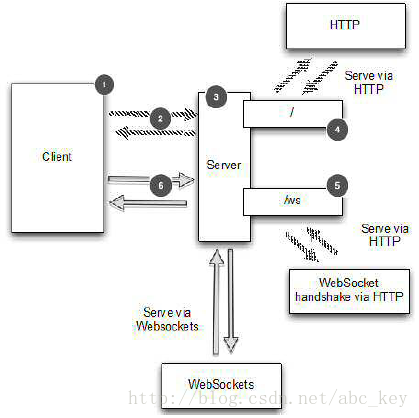文章目录
本文转自互联网博客,在此感谢博主的总结归纳,本文只提供于巩固复习使用
本章介绍
- WebSocket
- ChannelHandler,Decoder and Encoder
- 引导一个Netty基础程序
- 测试WebSocket
“real-time-web”实时web现在随处可见,很多的用户希望能从web站点实时获取信息。Netty支持WebSocket实现,并包含了不同的版本,我们可以非常容易的实现WebSocket应用。使用Netty附带的WebSocket,我们不需要关注协议内部实现,只需要使用Netty提供的一些简单的方法就可以实现。本章将通过的例子应用帮助你来使用WebSocket并了解它是如何工作。
11.1 WebSockets some background
关于WebSocket的一些概念和背景,可以查询网上相关介绍。这里不赘述。
11.2 面临的挑战
要显示“real-time”支持的WebSocket,应用程序将显示如何使用Netty中的WebSocket实现一个在浏览器中进行聊天的IRC应用程序。你可能知道从Facebook可以发送文本消息到另一个人,在这里,我们将进一步了解其实现。在这个应用程序中,不同的用户可以同时交谈,非常像IRC(Internet Relay Chat,互联网中继聊天)。
上图显示的逻辑很简单:
- 一个客户端发送一条消息
- 消息被广播到其他已连接的客户端
它的工作原理就像聊天室一样,在这里例子中,我们将编写服务器,然后使用浏览器作为客户端。带着这样的思路,我们将会很简单的实现它。
11.3 实现
WebSocket使用HTTP升级机制从一个普通的HTTP连接WebSocket,因为这个应用程序使用WebSocket总是开始于HTTP(s),然后再升级。什么时候升级取决于应用程序本身。直接执行升级作为第一个操作一般是使用特定的url请求。
在这里,如果url的结尾以/ws结束,我们将只会升级到WebSocket,否则服务器将发送一个网页给客户端。升级后的连接将通过WebSocket传输所有数据。逻辑图如下:
11.3.1 处理http请求
服务器将作为一种混合式以允许同时处理http和websocket,所以服务器还需要html页面,html用来充当客户端角色,连接服务器并交互消息。因此,如果客户端不发送/ws的uri,我们需要写一个ChannelInboundHandler用来处理FullHttpRequest。看下面代码:
package netty.in.action;
import io.netty.channel.ChannelFuture;
import io.netty.channel.ChannelFutureListener;
import io.netty.channel.ChannelHandlerContext;
import io.netty.channel.DefaultFileRegion;
import io.netty.channel.SimpleChannelInboundHandler;
import io.netty.handler.codec.http.DefaultFullHttpResponse;
import io.netty.handler.codec.http.DefaultHttpResponse;
import io.netty.handler.codec.http.FullHttpRequest;
import io.netty.handler.codec.http.FullHttpResponse;
import io.netty.handler.codec.http.HttpHeaders;
import io.netty.handler.codec.http.HttpResponse;
import io.netty.handler.codec.http.HttpResponseStatus;
import io.netty.handler.codec.http.HttpVersion;
import io.netty.handler.codec.http.LastHttpContent;
import io.netty.handler.ssl.SslHandler;
import io.netty.handler.stream.ChunkedNioFile;
import java.io.RandomAccessFile;
/**
* WebSocket,处理http请求
*
* @author c.k
*
*/
public class HttpRequestHandler extends
SimpleChannelInboundHandler<FullHttpRequest> {
//websocket标识
private final String wsUri;
public HttpRequestHandler(String wsUri) {
this.wsUri = wsUri;
}
@Override
protected void channelRead0(ChannelHandlerContext ctx, FullHttpRequest msg)
throws Exception {
//如果是websocket请求,请求地址uri等于wsuri
if (wsUri.equalsIgnoreCase(msg.getUri())) {
//将消息转发到下一个ChannelHandler
ctx.fireChannelRead(msg.retain());
} else {//如果不是websocket请求
if (HttpHeaders.is100ContinueExpected(msg)) {
//如果HTTP请求头部包含Expect: 100-continue,
//则响应请求
FullHttpResponse response = new DefaultFullHttpResponse(
HttpVersion.HTTP_1_1, HttpResponseStatus.CONTINUE);
ctx.writeAndFlush(response);
}
//获取index.html的内容响应给客户端
RandomAccessFile file = new RandomAccessFile(
System.getProperty("user.dir") + "/index.html", "r");
HttpResponse response = new DefaultHttpResponse(
msg.getProtocolVersion(), HttpResponseStatus.OK);
response.headers().set(HttpHeaders.Names.CONTENT_TYPE,
"text/html; charset=UTF-8");
boolean keepAlive = HttpHeaders.isKeepAlive(msg);
//如果http请求保持活跃,设置http请求头部信息
//并响应请求
if (keepAlive) {
response.headers().set(HttpHeaders.Names.CONTENT_LENGTH,
file.length());
response.headers().set(HttpHeaders.Names.CONNECTION,
HttpHeaders.Values.KEEP_ALIVE);
}
ctx.write(response);
//如果不是https请求,将index.html内容写入通道
if (ctx.pipeline().get(SslHandler.class) == null) {
ctx.write(new DefaultFileRegion(file.getChannel(), 0, file
.length()));
} else {
ctx.write(new ChunkedNioFile(file.getChannel()));
}
//标识响应内容结束并刷新通道
ChannelFuture future = ctx
.writeAndFlush(LastHttpContent.EMPTY_LAST_CONTENT);
if (!keepAlive) {
//如果http请求不活跃,关闭http连接
future.addListener(ChannelFutureListener.CLOSE);
}
file.close();
}
}
@Override
public void exceptionCaught(ChannelHandlerContext ctx, Throwable cause)
throws Exception {
cause.printStackTrace();
ctx.close();
}
}
11.3.2 处理WebSocket框架
WebSocket支持6种不同框架,如下图:
我们的程序只需要使用下面4个框架:
- CloseWebSocketFrame
- PingWebSocketFrame
- PongWebSocketFrame
- TextWebSocketFrame
我们只需要显示处理TextWebSocketFrame,其他的会自动由WebSocketServerProtocolHandler处理,看下面代码:
package netty.in.action;
import io.netty.channel.ChannelHandlerContext;
import io.netty.channel.SimpleChannelInboundHandler;
import io.netty.channel.group.ChannelGroup;
import io.netty.handler.codec.http.websocketx.TextWebSocketFrame;
import io.netty.handler.codec.http.websocketx.WebSocketServerProtocolHandler;
/**
* WebSocket,处理消息
* @author c.k
*
*/
public class TextWebSocketFrameHandler extends
SimpleChannelInboundHandler<TextWebSocketFrame> {
private final ChannelGroup group;
public TextWebSocketFrameHandler(ChannelGroup group) {
this.group = group;
}
@Override
public void userEventTriggered(ChannelHandlerContext ctx, Object evt)
throws Exception {
//如果WebSocket握手完成
if (evt == WebSocketServerProtocolHandler.ServerHandshakeStateEvent.HANDSHAKE_COMPLETE) {
//删除ChannelPipeline中的HttpRequestHandler
ctx.pipeline().remove(HttpRequestHandler.class);
//写一个消息到ChannelGroup
group.writeAndFlush(new TextWebSocketFrame("Client " + ctx.channel()
+ " joined"));
//将Channel添加到ChannelGroup
group.add(ctx.channel());
}else {
super.userEventTriggered(ctx, evt);
}
}
@Override
protected void channelRead0(ChannelHandlerContext ctx, TextWebSocketFrame msg)
throws Exception {
//将接收的消息通过ChannelGroup转发到所以已连接的客户端
group.writeAndFlush(msg.retain());
}
}
11.3.3 初始化ChannelPipeline
看下面代码:
package netty.in.action;
import io.netty.channel.Channel;
import io.netty.channel.ChannelInitializer;
import io.netty.channel.ChannelPipeline;
import io.netty.channel.group.ChannelGroup;
import io.netty.handler.codec.http.HttpObjectAggregator;
import io.netty.handler.codec.http.HttpServerCodec;
import io.netty.handler.codec.http.websocketx.WebSocketServerProtocolHandler;
import io.netty.handler.stream.ChunkedWriteHandler;
/**
* WebSocket,初始化ChannelHandler
* @author c.k
*
*/
public class ChatServerInitializer extends ChannelInitializer<Channel> {
private final ChannelGroup group;
public ChatServerInitializer(ChannelGroup group){
this.group = group;
}
@Override
protected void initChannel(Channel ch) throws Exception {
ChannelPipeline pipeline = ch.pipeline();
//编解码http请求
pipeline.addLast(new HttpServerCodec());
//写文件内容
pipeline.addLast(new ChunkedWriteHandler());
//聚合解码HttpRequest/HttpContent/LastHttpContent到FullHttpRequest
//保证接收的Http请求的完整性
pipeline.addLast(new HttpObjectAggregator(64 * 1024));
//处理FullHttpRequest
pipeline.addLast(new HttpRequestHandler("/ws"));
//处理其他的WebSocketFrame
pipeline.addLast(new WebSocketServerProtocolHandler("/ws"));
//处理TextWebSocketFrame
pipeline.addLast(new TextWebSocketFrameHandler(group));
}
}
WebSocketServerProtcolHandler不仅处理Ping/Pong/CloseWebSocketFrame,还和它自己握手并帮助升级WebSocket。这是执行完成握手和成功修改ChannelPipeline,并且添加需要的编码器/解码器和删除不需要的ChannelHandler。
看下图:
ChannelPipeline通过ChannelInitializer的initChannel(…)方法完成初始化,完成握手后就会更改事情。一旦这样做了,WebSocketServerProtocolHandler将取代HttpRequestDecoder、WebSocketFrameDecoder13和HttpResponseEncoder、WebSocketFrameEncoder13。另外也要删除所有不需要的ChannelHandler已获得最佳性能。这些都是HttpObjectAggregator和HttpRequestHandler。下图显示ChannelPipeline握手完成:
我们甚至没注意到它,因为它是在底层执行的。以非常灵活的方式动态更新ChannelPipeline让单独的任务在不同的ChannelHandler中实现。
11.4 结合在一起使用
一如既往,我们要将它们结合在一起使用。使用Bootstrap引导服务器和设置正确的ChannelInitializer。看下面代码:
package netty.in.action;
import io.netty.bootstrap.ServerBootstrap;
import io.netty.channel.Channel;
import io.netty.channel.ChannelFuture;
import io.netty.channel.ChannelInitializer;
import io.netty.channel.EventLoopGroup;
import io.netty.channel.group.ChannelGroup;
import io.netty.channel.group.DefaultChannelGroup;
import io.netty.channel.nio.NioEventLoopGroup;
import io.netty.channel.socket.nio.NioServerSocketChannel;
import io.netty.util.concurrent.ImmediateEventExecutor;
import java.net.InetSocketAddress;
/**
* 访问地址:http://localhost:2048
*
* @author c.k
*
*/
public class ChatServer {
private final ChannelGroup group = new DefaultChannelGroup(
ImmediateEventExecutor.INSTANCE);
private final EventLoopGroup workerGroup = new NioEventLoopGroup();
private Channel channel;
public ChannelFuture start(InetSocketAddress address) {
ServerBootstrap b = new ServerBootstrap();
b.group(workerGroup).channel(NioServerSocketChannel.class)
.childHandler(createInitializer(group));
ChannelFuture f = b.bind(address).syncUninterruptibly();
channel = f.channel();
return f;
}
public void destroy() {
if (channel != null)
channel.close();
group.close();
workerGroup.shutdownGracefully();
}
protected ChannelInitializer<Channel> createInitializer(ChannelGroup group) {
return new ChatServerInitializer(group);
}
public static void main(String[] args) {
final ChatServer server = new ChatServer();
ChannelFuture f = server.start(new InetSocketAddress(2048));
Runtime.getRuntime().addShutdownHook(new Thread() {
@Override
public void run() {
server.destroy();
}
});
f.channel().closeFuture().syncUninterruptibly();
}
}
另外,需要将index.html文件放在项目根目录,index.html内容如下:
<html>
<head>
<title>Web Socket Test</title>
</head>
<body>
<script type="text/javascript">
var socket;
if (!window.WebSocket) {
window.WebSocket = window.MozWebSocket;
}
if (window.WebSocket) {
socket = new WebSocket("ws://localhost:2048/ws");
socket.onmessage = function(event) {
var ta = document.getElementById('responseText');
ta.value = ta.value + '
' + event.data
};
socket.onopen = function(event) {
var ta = document.getElementById('responseText');
ta.value = "Web Socket opened!";
};
socket.onclose = function(event) {
var ta = document.getElementById('responseText');
ta.value = ta.value + "Web Socket closed";
};
} else {
alert("Your browser does not support Web Socket.");
}
function send(message) {
if (!window.WebSocket) { return; }
if (socket.readyState == WebSocket.OPEN) {
socket.send(message);
} else {
alert("The socket is not open.");
}
}
</script>
<form onsubmit="return false;">
<input type="text" name="message" value="Hello, World!"><input
type="button" value="Send Web Socket Data"
onclick="send(this.form.message.value)">
<h3>Output</h3>
<textarea id="responseText" style="width: 500px; height: 300px;"></textarea>
</form>
</body>
</html>
最后在浏览器中输入:http://localhost:2048,多开几个窗口就可以聊天了。
11.5 给WebSocket加密
上面的应用程序虽然工作的很好,但是在网络上收发消息存在很大的安全隐患,所以有必要对消息进行加密。添加这样一个加密的功能一般比较复杂,需要对代码有较大的改动。但是使用Netty就可以很容易的添加这样的功能,只需要将SslHandler加入到ChannelPipeline中就可以了。实际上还需要添加SslContext,但这不在本例子范围内。
首先我们创建一个用于添加加密Handler的handler初始化类,看下面代码:
package netty.in.action;
import io.netty.channel.Channel;
import io.netty.channel.group.ChannelGroup;
import io.netty.handler.ssl.SslHandler;
import javax.net.ssl.SSLContext;
import javax.net.ssl.SSLEngine;
public class SecureChatServerIntializer extends ChatServerInitializer {
private final SSLContext context;
public SecureChatServerIntializer(ChannelGroup group,SSLContext context) {
super(group);
this.context = context;
}
@Override
protected void initChannel(Channel ch) throws Exception {
super.initChannel(ch);
SSLEngine engine = context.createSSLEngine();
engine.setUseClientMode(false);
ch.pipeline().addFirst(new SslHandler(engine));
}
}
最后我们创建一个用于引导配置的类,看下面代码:
package netty.in.action;
import io.netty.channel.Channel;
import io.netty.channel.ChannelFuture;
import io.netty.channel.ChannelInitializer;
import io.netty.channel.group.ChannelGroup;
import java.net.InetSocketAddress;
import javax.net.ssl.SSLContext;
/**
* 访问地址:https://localhost:4096
*
* @author c.k
*
*/
public class SecureChatServer extends ChatServer {
private final SSLContext context;
public SecureChatServer(SSLContext context) {
this.context = context;
}
@Override
protected ChannelInitializer<Channel> createInitializer(ChannelGroup group) {
return new SecureChatServerIntializer(group, context);
}
/**
* 获取SSLContext需要相关的keystore文件,这里没有 关于HTTPS可以查阅相关资料,这里只介绍在Netty中如何使用
*
* @return
*/
private static SSLContext getSslContext() {
return null;
}
public static void main(String[] args) {
SSLContext context = getSslContext();
final SecureChatServer server = new SecureChatServer(context);
ChannelFuture future = server.start(new InetSocketAddress(4096));
Runtime.getRuntime().addShutdownHook(new Thread() {
@Override
public void run() {
server.destroy();
}
});
future.channel().closeFuture().syncUninterruptibly();
}
}




